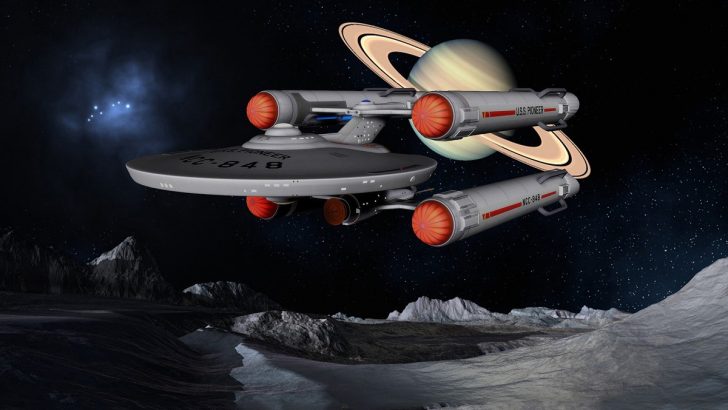The “U.S.S” from Star trek mean “United Space Ship” then as the lore fleshed out it would be know as “United Star Ship”.
Star Trek is a staple of modern science fiction.
With some of the most well-known characters of the genre, as well as over 50 years of history and stories to boot, it has cemented itself as one of the all-time great franchises.
Being a classic science fiction show, Star Trek is home to some of the most iconic ship designs of the genre, too.
The USS Enterprise has one of the most iconic silhouettes in all of sci-fi, rivaling anything from the other major franchises that have dominated the genre, from Star Wars to Battlestar Galactica, to Starship Trooper, and many others.
However, when many people first hear the full title of the iconic main ship of the series, the USS Enterprise, many people are often confused by the name.
After all, in the Utopian vision of the future which is the 23rd century, why would the United States need to keep up its military?
The answer to this question is long, fascinating, and just a little bit convoluted. But don’t worry, there is an answer!
In this article, we are going to explain the origins of both the USS Enterprise, and how the ship got that name, both in-universe, and in the real world.
If you are a fan of behind-the-scenes show development or love a little in-universe lore and history for your favorite science fiction ship and show, you’ve come to the right place!
The USS Enterprise: The First Star Trek Ship
Of course, we can’t exactly talk about Star Trek, especially the ‘USS’, without at least mentioning the first ship that sported this abbreviation, the USS Enterprise.
While many spaceships in the universe of Star Trek have had this title, the first ship of its line that we were introduced to was the iconic ship from the Original Series, which debuted in 1966.
Before the Iconic Captain Kirk takes the helm at the start of the Original Series, the ship from the Unites StarShips (USS) Fleet had two previous captains, first Robert April, who commanded the ship shortly after it was first commissioned in 2245, then followed by Christopher Pike, who would go on to captain the ship for 10 years in the Star Trek universe, before commands fall to Captain James T. Kirk.
In the original Star Trek series, the USS Enterprise is an exploration ship that has been tasked with cataloging new life and planets over a 5-year mission, or, as the tagline of the show says, “to boldly go where no man has gone before“.
It is the main base of operations for the crew of the ship for both the initial run of the series from 1966 to 1969, and the animated series that ran from 1973 to 1974, and is also featured in the first several Star Trek movies, being under new command with Captain William Decker in Star Trek: The Motion Picture, before the position of command is given back to Captain Kirk, and commanded by Spock in Star Trek II: The Wrath of Khan, before Kirk again assumes command of the ship.
In Star Trek III: The Search for Spock, the USS Enterprise was intended to be decommissioned by Starfleet, before it is stolen by Kirk and the crew to find and revive Spock.
The ship is destroyed during the film, as a trap for Klingons set by Kirk who had already captured the ship.
This, technically, is the final outing of the original Starship Enterprise.
Other USS Enterprises

However, with a ship as iconic as the USS Enterprise, it is not surprising that new versions of the ship have been introduced to the Star Trek Universe.
The last few Star Trek movies that featured the original cast featured a direct successor ship to the original Enterprise, the Enterprise-A, and the successor series to the original show, Star Trek: The Next Generation, would feature another successor Enterprise vessel, the Enterprise D to carry out a very similar role to the original ship.
The last version of the USS Enterprise, the Enterprise NX, the original ship, appears in Star Trek: Enterprise as the main setting for the crew of the series.
The Origins Of The Term In Star Trek
Of course, these are all in-universe explanations for the names of the ship and its designation.
Where exactly did the name and the title come from?
During pre-production for the Original 1966 series, Gene Roddenberry, task the original art director for the series, Matt Jefferies with creating an iconic ship that would be the focal point for the crew and story, and would be as much of a character in itself.
Jefferies, after many attempts to create a unique design that would be unlike any air or spaceship of the time, would eventually create the large saucer and two extended engine shapes that would become known around the world.
All they needed for it was a name.
There had been plans for the ship to be known as Yorktown, but the end name ended up being influenced by Roddenberry’s love of maritime navy ships.
How “Yorktown” Found Its Place in Star Trek
Although the Enterprise ultimately took center stage, the name “Yorktown” wasn’t lost to the creative ether. Instead, “Yorktown” resurfaced throughout the Star Trek universe, lending its historic flair to various ships and even locations. For example, fans spotted the name attached to starships in later series, and notably, a massive space station called Yorktown played a pivotal role as a sprawling Federation hub in Star Trek Beyond.
So, while the original USS Yorktown never made its television debut as the flagship, its legacy continues to orbit throughout the Trek universe, quietly honoring its nautical inspiration.
More specifically, his fascination with the iconic United States aircraft carrier of the same name, the USS Enterprise.
However, to fit into the world that Gene Roddenberry and the crew of the Original Series had created, having a spaceship named after the United States military would run counter to the Utopian vision that they wanted to create.
So, as a result, the USS, originally meaning ‘United States Ship’, would instead mean ‘United Space Ship’. As the lore and world-building of the Star Trek universe continued to be fleshed out, the designation would eventually mean ‘United Star Ship’.
On-Screen References to “United Space Ship”
But did “U.S.S.” ever actually stand for “United Space Ship” in the show itself?
In fact, it did—at least in a few early moments. If you look closely at the original series pilot, “The Cage,” and a later episode, “Patterns of Force” (first aired in 1968), dialogue suggests that “U.S.S.” means “United Space Ship.” These were small, passing references, and much like Spock once describing himself as “Vulcanian” instead of “Vulcan,” Trek fans have been known to give these details a quiet pass as the series evolved. Still, as the Star Trek universe became more fully realized, “U.S.S.” settled into its now-canonical meaning: “United Star Ship.”
Stephen E. Whitfield’s Definitive Take
Interestingly, when it comes to nailing down the official meaning behind “U.S.S.” in the world of Star Trek, we can look to Stephen E. Whitfield’s seminal book, The Making of Star Trek. Whitfield clarifies that, within the franchise, “U.S.S.” stands for “United Star Ship.” This designation fits perfectly with Star Trek’s dedication to portraying an inclusive and multicultural future—one that goes beyond the boundaries of a single nation or military tradition and instead embraces the idea of a united exploration of the stars.
Behind-the-Scenes Debates Over “U.S.S.”
Interestingly, not everyone agreed on what “U.S.S.” should stand for when the original series was being developed. Some NBC executives, perhaps used to seeing “U.S.S.” on American naval ships, assumed it meant the Enterprise was a purely American vessel—an extension of the Stars and Stripes sailing through the cosmos.
Gene Roddenberry, however, had other plans. His vision for Star Trek was an inclusive future where Earth was united, free from the divisions of nations. When pitched the idea that “U.S.S.” should cement the Enterprise as an American ship, Roddenberry firmly pushed back. He believed the spacecraft—and the future it represented—belonged to all of humanity, not just one country.
This behind-the-scenes tug-of-war is even chronicled in Stephen E. Whitfield’s classic reference, The Making of Star Trek, which ultimately solidified “U.S.S.” as “United Star Ship.” The designation reflects the diverse, global—and even interplanetary—crew that became the hallmark of the franchise, a subtle but significant nod to the show’s core message of unity.
Starfleet’s Organization: A Nod to Naval Tradition, with a Twist
This attention to names and designations isn’t just cosmetic—it speaks to a deeper organizational structure within Starfleet that draws heavily from real-world naval practices. Much like the U.S. Navy or the Royal Navy, Starfleet keeps meticulous records of its ships, assigning each vessel a registry number that tracks its service, class, and place within the ever-expanding fleet. This isn’t just for show; it hints at a sprawling, well-oiled bureaucracy humming away behind the scenes, complete with legions of Starfleet staff cataloging, coordinating, and—presumably—debating the best shade of Starfleet gray for the warp nacelles.
But where modern navies are built around national defense, power projection, and sometimes a dash of flag-waving, Starfleet flips the script. The military-style hierarchy and formal registration serve the goals of science and exploration rather than dominion or deterrence. Instead of preparing for the next big naval engagement, Starfleet’s “admiralty” focuses on dispatching survey missions, peaceful diplomatic assignments, and the occasional archaeological treasure hunt on far-flung planets.
In this way, Starfleet feels both familiar and aspirational. It marries the rigor and order of maritime tradition with the hopeful optimism of a universe where discovery and understanding take precedence over conflict.
Final Thoughts
So, whilst the technical origins of the ship designation are the same as the United States Navy, it has gone on to mean something completely different, now the ship of a united fleet of a united federation.




